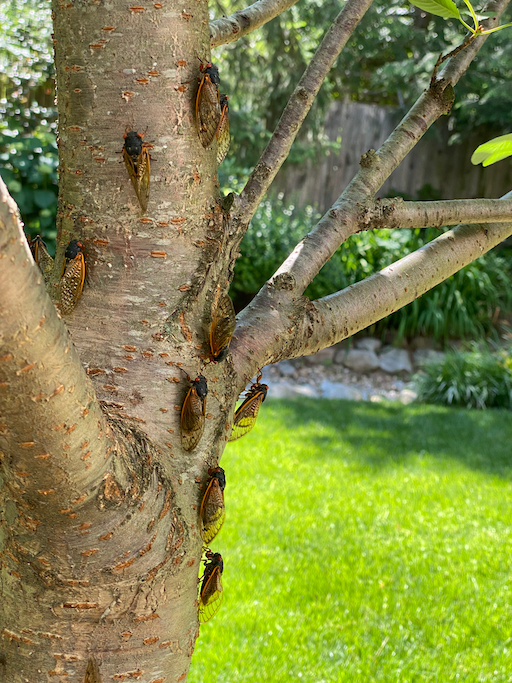Disclaimer: I want to make crystal clear, right up-front that although various recipes for cooking cicadas appeared in the local media, WE DID NOT COOK OR EAT ANY and this is not a blog on “how to serve Cicadas.” If that is what you were looking for, please move on. With that out of the way, today’s blog is not about food. It is about commemorating a wonder-of-nature that just took place in the Washington area this year; the emergence of the 17 year cicadas Brood X.
Cicadas or "semi" 蝉 are very common in Japan. When I was growing up, my brother and I collected cicada nymphs when they emerged from the ground and started climbing the trees in the early evening. We brought them inside and let them spend the night clinging to the curtains in our bedroom. (Yes my mother was a saint). They would molt during the night and by the time we woke up the next morning, they were all dry and ready to fly. It was this transformation that fascinated us. After observing them for some time we just let them go. The cicadas of my childhood came out every year. They had brown eyes and opaque brown wings and were called "aburazemi" 油蝉 or "
Large brown cicada". They spent about 3 years under ground but their emergence was not synchronized. So every year, a batch of about the same number would appear.
In contrast, while the area where we live now has cicada every year, it is also characterized by the emergence of "periodic cicadas". These are cicada that synchronize their emergence to come out en mass (read, in the billions) as a strategy to overwhelm any predators so enough will survive to procreate. The most impressive is the emergence of the 17 year cicada. They spend 17 years living under ground feeding on the sap of tree roots before they emerge, molt into their adult winged form, issue their deafening shrill mating call, mate, lay their eggs in trees and die. They are unique to the eastern United States. None of the other 3,400 species of cicada worldwide do this. There are three species of 17-year cicadas—
Magicicada septendecim, M. cassinii and M. septendecula. They form mixed-species cohorts called broods whose members arise like clockwork on the same schedule. The broods are identified by Roman numerals. There are 12 of them identified according to the regions of the United States in which they appear. For example, Brood I, the Shenandoah brood so named because it appears in the Shenandoah valley area, or XIX the Great Southern Brood appears in the U.S. southeast. Brood X, known as the Great Eastern Brood is the largest of the 12 broods and it is the one that made it’s appearance in the Washington area this year. The cicada that appeared this year were spawned 17 years ago in 2004 when their “parents” last emerged. (This is a very long lived insect. If these were kids they would be thinking about attending college). The number in which they emerge is truly mind boggling. Their mating call is deafening. Heard from a distance it sounds unworldly—like a space ship—and it goes on for about a month.
More cicadas are "resting" on the hosta leaves.
Brood X periodic cicada is much smaller than the cicada I am familiar with in Japan. They are also more colorful; quite the fashionista with the red colored eyes and transparent gold wings as shown in the portrait here. And check out the golden legs.
They are harmless rather awkward flyers, bumbling into things, flipping upside down when landing, feet flailing in the air, minutes spent righting themselves, walking mechanically one leg after the other somewhat like a wound-up robot. Think about it. You spend your entire life (17 years) in the dark, underground, wingless. Then suddenly, literally overnight, you find yourself above ground, in the light, in an entirely different body, with wings no less. Is it any wonder that it takes some time for them the pass the “driving test” in these new bodies? While we were sitting outside in our backyard, they made themselves quite at home, landing and crawling all over the place. The one shown here is checking its email.
Here is one taking selfies.
This one stopped by for an espresso.
Apparently pets (especially dogs) and wild animals (rats. mice, squirrels and birds) enjoy this bounty which for them is food. We watched a resident squirrel grab a cicada, rip off its wings, head and eat the rest all within seconds. Then eventually the squirrels became satiated. There were just too many cicada for them to eat so, in typical squirrel fashion, they started burying them. (Not sure how that helped. We pointed out to the squirrel that the next generation cicada in larva form would eventually end up underground again so burying the parent that was going to die anyway would not be helpful). Ok the recipes we saw in the media during this event were interesting in a certain intellectual sense but we were certainly not into it. We decided to leave the cicadas to the other gourmets such as the squirrels. Although this emergence of Brood X cicadas looked somewhat smaller and not as noisy or numerous than as the one 17 years ago, it was still one of the best floor shows put on by nature.







No comments:
Post a Comment